Q&A – Ask Neil: October 26, 2023
(Please read these instructions carefully.)
Before you post your question, please look at recent issues to see if someone else has already asked it. You might find your answer there.
How to submit your question…
(Note: You may need to allow a pop-up window to come up in order to get the link for sending your photo(s). If you have already submitted your question and didn’t see the pop-up window, please click here.)
• Click the link provided below to post your question. After you submit your question, a new window will pop up giving you the address to which you can e-mail a SHARP, HIGH-RESOLUTION PHOTO to accompany your question. Please DO NOT SEND THUMBNAIL PHOTOS in case I need to zoom in to see things.
• Click here to post your question.
• Please ONLY POST YOUR QUESTION ONE TIME. We can only accept a set number of questions each week, and when we get duplicates it costs other people their chances.
• One question per reader, please.
• Please use this only for posting questions – not for standard emails.
• Watch for your answer in the following week’s e-gardens.
• I choose those of greatest general interest. For example, plant IDs seldom make the cut.
• I must have your first name or initials.
• I must have your city or county. (Texas is a very large state.)
QUESTION 1
WHY WON’T MY CHINESE PHOTINIA CUTTINGS ROOT?
Question: I’ve tried to propagate Chinese photinias from cuttings. I’ve used a larger plastic container with a lid to keep consistent moisture in the soil. I used rooting hormone powder on the cuttings. But no roots after 1-1/2 months. Any ideas why? Bredt W., Parker.
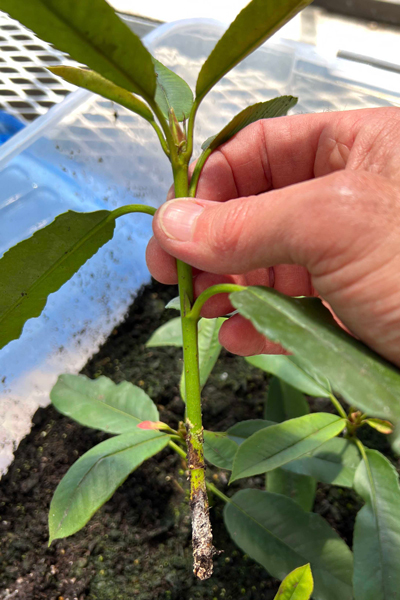
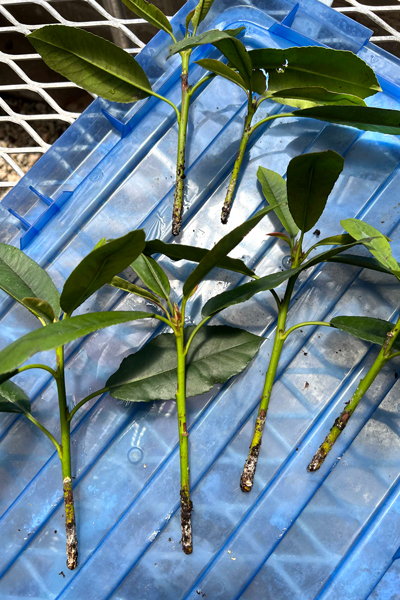
Answer: I’ve always propagated them from seed, Bredt. They are ripening on the plants right now. You’ll find them by the thousands if you can just find a mature plant or two. Look in an older neighborhood (1950s or before) and they should be plentiful.
As for your cuttings, my bet would be that you took them too late in the growing season. “Softer” cuttings taken in early summer root better for many shrubs. Trim off the green tip growth and otherwise handle them pretty much the way that you have. One other thing you might try is “wounding” the bases of the stems. Take a sliver of the bark off opposite sides before you dip the cuttings in the rooting hormone powder. Tap off the excess powder. You don’t want too much.
Good luck!
QUESTION 2
WHY IS MY ‘WHITE PILLAR’ ALTHAEA CHANGING COLORS?
Question: My ‘White Pillar’ althaea is changing colors. What can I do? Elizabeth K., Plano.

Answer: It has mutated. If you trace all the lavender flowers back toward the main stem/roots, you will find that they all originate from one original stem. Trim to remove that part of the plant and you will have removed the mutation. That doesn’t mean that others won’t pop up. I don’t know that variety, but plants that mutate often tend to mutate rather freely.
QUESTION 3
WHAT IS KILLING REDCEDARS?
Question: In a previous e-gardens you mentioned that your redcedars had a disease and that you had lost several of them. We planted ours 45 years ago and now they are dying one after the other. Help! Dee H., Wellborn, Brazos County.
Answer: We have perhaps 200 eastern redcedars on our 11 acres in Collin County. It’s the same juniper (Juniperus virginiana) that you have in Brazos County (where I grew up). But the junipers I have lost in our landscape are not our native redcedars. They were Spartan and the old Table Top Blue. Blue Point junipers are even more susceptible, and it’s due to one of two similar diseases: Phomopsis twig blight and Kabatina twig blight (https://hgic.clemson.edu/factsheet/juniper-diseases-insect-pests/).
As for your redcedars dying, that’s almost assuredly from this year’s drought. In traveling to Houston two weeks ago I saw scores of them dead along the roadsides. No diseases. No insects. Just because not enough water.
QUESTION 4
HOW CAN I GET RID OF SNAILSEED VINE?
Question: How can I get rid of snailseed vine? I used Roundup full strength, Triclopyr and anything else I could find. It’s still there. Deborah S., Lancaster.
Answer: Isn’t it funny how a lovely little native vine can become an obnoxious weed! Snailseed vine has such an assertive system of rhizomes that sprays usually do not do much good. Oh, and don’t use products at “full strength.” That usually results in fast burning of the top growth without killing the root system.
I’ve always had the best luck by hoeing snailseed vines out, then covering the bed with weedblocking landscape fabric to stop resprouting from the root systems. I put bark mulch on top of the fabric so it’s not so industrial looking, and I leave it in place for a couple of years.
QUESTION 5
HOW CAN WE COPE WITH DEER WHEN IT’S SO DRY?
Question: Do you have any suggestions on what we can plant that won’t be destroyed by deer? With all the drought they’ve made themselves at home in our landscape and gardens. Rita N., Denton County.
Answer: Our best bet is to pray for rain. That would solve a lot of problems, both winter and next spring alike. Fortunately, we’ve gotten a start this week!
However, to give you a better answer, I’ll refer you to a list I mentioned here in e-gardens a few weeks ago. Forrest Appleton has assisted my friend Dr. Jerry Parsons, TAMU Extension Horticulture Professor Emeritus for many years. Forrest’s list of deer-resistant plants that Jerry includes in his Plant Answers website is the best list I’ve seen. Take a look: https://www.plantanswers.com/Articles/DeerResistantList.asp
QUESTION 6
SHOULD I TAKE ONE OF THESE TREES OUT OR KEEP THEM TRIMMED SO THEY DO NOT GROW TOGETHER?
Question: A previous owner planted these two live oak trees. Should I remove one of the trees, or keep them trimmed so they do not grow together? Molly F., Montgomery.
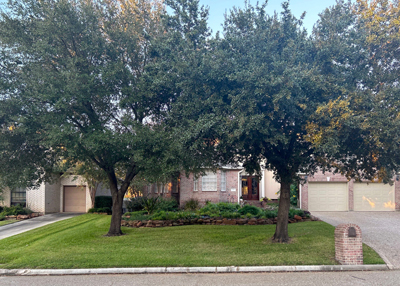
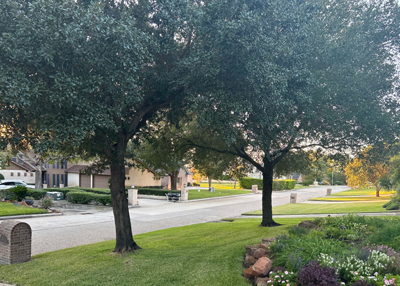
Answer: I’m hoping I get a third choice: I would do neither of those. Leave them alone to grow into a single mass. In retrospect, I would have only planted one of them, and it probably would have been off to the left. But the right tree is the prettier of your two. If this were my landscape, I’d let them grow together, and if the shade caused my St. Augustine to thin out eventually, I’d widen the retaining wall out toward the front to include the righthand tree. You wouldn’t have to change the grade at all, so it wouldn’t hurt the tree, but it would allow you to compensate for the lack of symmetry. “Two” is an awkward number to work into a design. (You’ve done a nice job with your landscape. I hope this is of help.)
QUESTION 7
WHAT MIGHT BE WRONG WITH MY HOLLIES?
Question: My hollies are 25 years old. These were planted on the east side of the house and are mostly shaded all day long by pecan trees. They all get the same amount of water and mulch. The bushes on the north side of the front steps are much fuller. Those on the south side are thin and sickly. Why the difference? Tim S., Troy.
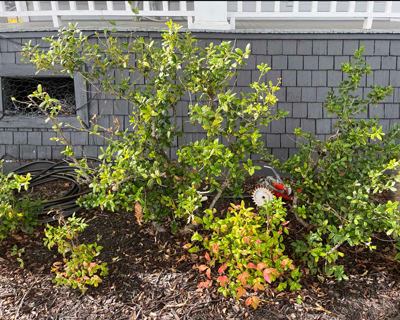
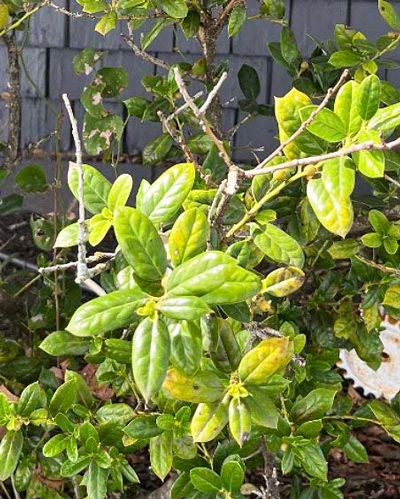
Answer: Tim called my radio program on KLIF this past weekend. I asked him to send me photos so I could be more accurate in my answers. Now it’s my turn to prove that!
Tim, these appear to be dwarf Burford holly. Given 25 years they can grow that tall.
Your plants are very hungry. You can see that in the nandinas as well. They all need nitrogen. It’s too late in the growing season to put it out for this year, but I would come out of the blocks around March 1 with an application of an all-nitrogen food. In fact, I may go out of character by suggesting you use ammonium sulfate (21-0-0). It is not a good product to use on a regular basis (the equivalent of “junk food” for humans), but this is almost an emergency. Keep it off the St. Augustine – just the hollies and nandinas. Scratch it into the soil and water slowly and deeply immediately afterwards.
As to why these plants might be showing this deficiency when the other plants are not, please look at the difference in the size of the two pecan trees. The tree over the plants on the right is not nearly as full. It’s not drawing as much water and nutrition as the tree on the left.
I’m concerned that these plants have been trimmed many times and may have run out of steam. The nitrogen should promote vigorous new growth next spring. If that fails to happen, you may end up having to replace them.
Good luck. Thanks for listening!

